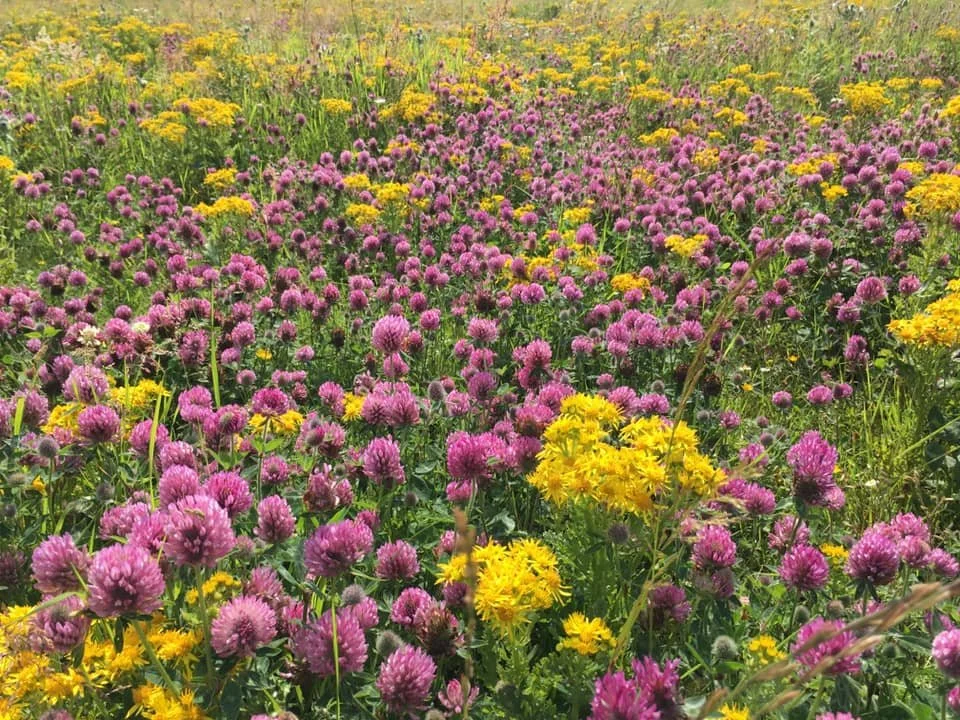#89 Ragwort by Becky Austin
Meet Becky Austin, Assistant Warden at RSPB St Aidan’s and Fairburn Ings!
Becky Austin is a nature enthusiast living in Bingley, West Yorkshire. She has worked and volunteered for several conservation organisations since 2013. Most of her conservation career has been spent working in Scotland at RSPB Loch Lomond and the Orkney Islands. Having moved back to West Yorkshire in 2019, Becky worked for Yorkshire Wildlife Trust doing her dream job of Reserves Assistant in the Yorkshire Dales. Becky developed a chronic illness, Myalgic Encephalomyelitis (ME), in April 2021 and since then has been focusing on her health, enjoying nature in her garden and further afield where possible. She returned to conservation work in May as an Assistant Warden with the RSPB at St Aidan’s and Fairburn Ings.
With her chronic illness stabilised Becky also volunteers for BTO undertaking a local WeBS survey and for Froglife at a local Toad Crossing. Becky regularly attends the RSPB Leeds Local Group outings and has recently joined Wharfedale Naturalists. Becky’s main passion is for birds, but she has a love of all nature and is always eager to learn about the natural world. When not spending time in her garden or outside in nature Becky loves to embroider, knit, read and play Table Top Role Play Games.
Becky’s chosen species is Common Ragwort Senecio jacobaea; one of her favourite plants, having fallen for it and the many invertebrates it supports. Becky’s love of Ragwort started when she led the bumblebee surveys on Orkney and noted the number of invertebrates using the plant, particular later in the season as fewer nectar rich plants were available.
Close up image of Ragwort
Common Ragwort Senecio jacobaea is an ecologically important wildflower native to the UK. It is a relatively tall plant, with large flat-topped clusters of bright yellow, daisy like, flower heads. It is an extremely important plant for invertebrates, and so it should come as no surprise to you, that she is writing the following sat firmly inside camp Common Ragwort! You can find out more about Ragwort on the NBN Atlas: Jacobaea vulgaris : Common Ragwort | NBN Atlas.
Common Ragwort is a native plant and is found in every 10km square in Yorkshire and almost every 10km square in the whole of the British Isles. It is commonly found on wasteland, grassland, verges, woodland rides and coast land. It can tolerate soils from Ph5-7 and grow in elevations from 0-1,020 metres. It produces thousands of seeds, most of which germinate within 12m of the parent plant.
So, what is so special about this leggy yellow weed? For starters, Ragwort is an important food source for many invertebrates, including hoverflies, bumblebees, butterflies and moths. In fact, Common Ragwort is one of the most visited plants by butterflies and there are several species of invertebrates that are dependent on it as their only food source. Even different species of fungi benefit and depend on Ragwort.
The species most synonymous with Common Ragwort is the Cinnabar moth, which is common all over the county wherever Ragwort grows. Common Ragwort is one of the food plants of the Cinnabar caterpillar, supporting this yellow and black caterpillar which is highly distasteful to most predators due to ingesting the toxins in the plant.
Ragwort has been used as an herbal treatment for many ailments in the past and has and can be used to dye fabrics green (leaves) or yellow (flowers).
Now, it is important to address the elephant in the room. Even while waving yellow pompoms and cheering on this countryside delight, there is no avoiding the fact that Ragwort contains pyrrolizidine alkaline which, if the plant is ingested, is toxic to humans, horses and cattle. Ragwort has evolved this way as a defence mechanism against grazing animals. Unfortunately, this puts grazing animals at risk of becoming ill and even dying if they consume 5-25% of their body’s weight in Ragwort.
Corn Bunting on Ragwort
However, if the pasture does not become over-grazed, reducing the availability of food, most grazing animals will choose not to eat Ragwort due to its bitter taste. Of course, nobody wants any harm to come to grazing animals, but it is important to find a balance between protecting grazing animals, neighbouring land, and this ecologically important plant. So, if you want to prevent or reduce Ragwort (but avoid removing it all together, which a whole host of invertebrates would thank you for) practice good grassland management. This means keeping a healthy grass structure of at least 5cm through the grazing period and ensuring there is no bare ground. This can be achieved through stock rotation and reducing grazing pressure.
The biggest risk arises when Ragwort is present in an area cut for haylage or silage. Once cut, grazing animals cannot distinguish between it and other plants. In areas where cutting takes place for haylage or silage, Ragwort must be removed prior to cutting.
Now we have covered how to manage dangers to grazing animals, what about us? Is this happy yellow plant enticing us closer with its abundance of interesting invertebrates to observe, only to wipe us out? Definitely not. Whilst Ragwort is toxic, many other of our favourite plants such as Foxglove and Bluebells also contain toxins. Poisoning, by what is a highly distasteful plant, would involve consuming a rather large quantity of it! If you avoid this, which shouldn’t be too hard, Ragwort poses you no threat! It is worth bearing in mind that some people can get a rash if they touch the plant, so if you are pulling it up, it’s best to wear gloves.
Becky chose Common Ragwort due to its general bad press: ‘I thought people may benefit from hearing about the positive attributes of the plant. This does not minimise the distress and financial loss that horse and cattle owners suffer and go through if an animal dies due to ingesting Ragwort. This is unlikely to occur if good grassland management is practiced and Ragwort is removed prior to silage or haylage being cut. So, I have braved sticking my head above the parapets and shouting to the world ‘My name is Becky, and I love Ragwort!’ Now I just wait, and hope, that after you’ve read this, I may not be alone!’
Recording and monitoring
There are no current specific recording schemes for this plant, but Common Ragwort is recorded in the BSBI Plant Atlas and records can be submitted on the BSBI website.
Further information and acknowledgements
NEYEDC would like to thank Becky for her time and expertise in helping to create this blog.
Ragwort and Red Clover




